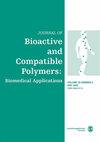罗非鱼皮肤胶原蛋白海绵的生物相容性、止血性能和伤口愈合评价
IF 2.2
4区 生物学
Q3 BIOTECHNOLOGY & APPLIED MICROBIOLOGY
引用次数: 8
摘要
采用冷冻干燥法制备了透析罗非鱼皮胶原蛋白海绵(DTSCS)和自组装罗非鱼皮胶原蛋白海绵(STSCS)。从罗非鱼鱼皮中分离纯化了用于制备DTSCS和STSCS的原料成分。预计这些胶原蛋白海绵可以发展成为止血和伤口愈合的医用敷料。本研究旨在探讨DTSCS和STSCS作为医用敷料的可能性,并通过扫描电镜(SEM)、吸水率测量、差示扫描量热法(DSC)、孔隙度测量、细胞毒性、溶血、体内生物相容性以及止血性能和伤口愈合评价来比较它们的差异。结果表明,DTSCS和STSCS具有疏松多孔的结构、高吸水性、高孔隙率和高热稳定性,适合用于医疗领域。该材料还显示出良好的生物相容性,包括良好的血液相容性,缺乏细胞毒性,植入后无明显排斥反应。STSCS具有快速止血和促进愈合的作用,其疗效略高于DTSCS。DTSCS的止血性能和促进愈合的作用与市售牛胶原海绵相似。因此,DTSCS和STSCS都是作为止血剂和伤口敷料的极具潜力的候选材料。本文章由计算机程序翻译,如有差异,请以英文原文为准。
Biocompatibility, hemostatic properties, and wound healing evaluation of tilapia skin collagen sponges
Dialyzed tilapia skin collagen sponge (DTSCS) and self-assembled tilapia skin collagen sponge (STSCS) were prepared by freeze-drying. The raw components used in the fabrication of DTSCS and STSCS were separated and purified from tilapia fish skin. It is anticipated that these collagen sponges could be developed into medical dressings for hemostasis and wound healing. The aim of the present research was to explore the possibility of DTSCS and STSCS as medical dressings and compare their differences by scanning electron microscopy (SEM), water absorption measurement, differential scanning calorimetry (DSC), measurement of porosity, cytotoxicity, hemolysis, in vivo biocompatibility, and evaluation of hemostatic performance and wound healing. The results indicate that DTSCS and STSCS are suitable materials for use in medical applications with a loose and porous structure, high water absorption, high porosity, and high thermal stability. The materials also displayed good biocompatibility, including excellent blood compatibility, a lack of cytotoxicity, with no apparent rejection following implantation. STSCS exhibited rapid hemostasis and promoted healing, with slightly greater efficacy than DTSCS. The hemostatic properties and promotion of healing in DTSCS was similar to that of commercial bovine collagen sponge. Therefore, DTSCS and STSCS both represented excellent potential candidate materials for use as hemostatic agents and wound dressings.
求助全文
通过发布文献求助,成功后即可免费获取论文全文。
去求助
来源期刊

Journal of Bioactive and Compatible Polymers
工程技术-材料科学:生物材料
CiteScore
3.50
自引率
0.00%
发文量
27
审稿时长
2 months
期刊介绍:
The use and importance of biomedical polymers, especially in pharmacology, is growing rapidly. The Journal of Bioactive and Compatible Polymers is a fully peer-reviewed scholarly journal that provides biomedical polymer scientists and researchers with new information on important advances in this field. Examples of specific areas of interest to the journal include: polymeric drugs and drug design; polymeric functionalization and structures related to biological activity or compatibility; natural polymer modification to achieve specific biological activity or compatibility; enzyme modelling by polymers; membranes for biological use; liposome stabilization and cell modeling. This journal is a member of the Committee on Publication Ethics (COPE).
 求助内容:
求助内容: 应助结果提醒方式:
应助结果提醒方式:


